The yeast par-1 homologs kin1 and kin2 show genetic and physical interactions with components of the exocytic machinery
- PMID: 15563607
- PMCID: PMC545889
- DOI: 10.1091/mbc.e04-07-0549
The yeast par-1 homologs kin1 and kin2 show genetic and physical interactions with components of the exocytic machinery
Abstract
Kin1 and Kin2 are Saccharomyces cerevisiae counterparts of Par-1, the Caenorhabditis elegans kinase essential for the establishment of polarity in the one cell embryo. Here, we present evidence for a novel link between Kin1, Kin2, and the secretory machinery of the budding yeast. We isolated KIN1 and KIN2 as suppressors of a mutant form of Rho3, a Rho-GTPase acting in polarized trafficking. Genetic analysis suggests that KIN1 and KIN2 act downstream of the Rab-GTPase Sec4, its exchange factor Sec2, and several components of the vesicle tethering complex, the Exocyst. We show that Kin1 and Kin2 physically interact with the t-SNARE Sec9 and the Lgl homologue Sro7, proteins acting at the final stage of exocytosis. Structural analysis of Kin2 reveals that its catalytic activity is essential for its function in the secretory pathway and implicates the conserved 42-amino acid tail at the carboxy terminal of the kinase in autoinhibition. Finally, we find that Kin1 and Kin2 induce phosphorylation of t-SNARE Sec9 in vivo and stimulate its release from the plasma membrane. In summary, we report the finding that yeast Par-1 counterparts are associated with and regulate the function of the exocytic apparatus via phosphorylation of Sec9.
Figures


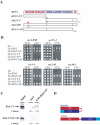


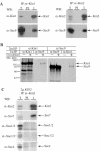
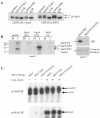
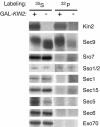
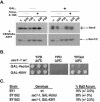
Similar articles
-
Substrate priming enhances phosphorylation by the budding yeast kinases Kin1 and Kin2.J Biol Chem. 2018 Nov 23;293(47):18353-18364. doi: 10.1074/jbc.RA118.005651. Epub 2018 Oct 10. J Biol Chem. 2018. PMID: 30305396 Free PMC article.
-
Kin2, the Budding Yeast Ortholog of Animal MARK/PAR-1 Kinases, Localizes to the Sites of Polarized Growth and May Regulate Septin Organization and the Cell Wall.PLoS One. 2016 Apr 20;11(4):e0153992. doi: 10.1371/journal.pone.0153992. eCollection 2016. PLoS One. 2016. PMID: 27096577 Free PMC article.
-
Characterization of the KIN2 gene product in Saccharomyces cerevisiae and comparison between the kinase activities of p145KIN1 and p145KIN2.Yeast. 1994 Jan;10(1):113-24. doi: 10.1002/yea.320100111. Yeast. 1994. PMID: 8203145
-
KIN1 and KIN2 protein kinases localize to the cytoplasmic face of the yeast plasma membrane.Exp Cell Res. 1994 Jul;213(1):93-9. doi: 10.1006/excr.1994.1177. Exp Cell Res. 1994. PMID: 8020610
-
Adaptation to Endoplasmic Reticulum Stress Requires Transphosphorylation within the Activation Loop of Protein Kinases Kin1 and Kin2, Orthologs of Human Microtubule Affinity-Regulating Kinase.Mol Cell Biol. 2018 Nov 13;38(23):e00266-18. doi: 10.1128/MCB.00266-18. Print 2018 Dec 1. Mol Cell Biol. 2018. PMID: 30201804 Free PMC article.
Cited by
-
Mechanisms regulating the protein kinases of Saccharomyces cerevisiae.Eukaryot Cell. 2007 Apr;6(4):571-83. doi: 10.1128/EC.00026-07. Epub 2007 Mar 2. Eukaryot Cell. 2007. PMID: 17337635 Free PMC article. Review. No abstract available.
-
Identification of stress responsive genes by studying specific relationships between mRNA and protein abundance.Heliyon. 2018 Mar 8;4(3):e00558. doi: 10.1016/j.heliyon.2018.e00558. eCollection 2018 Mar. Heliyon. 2018. PMID: 29560469 Free PMC article.
-
Coordinated protein sorting, targeting and distribution in polarized cells.Nat Rev Mol Cell Biol. 2008 Nov;9(11):833-45. doi: 10.1038/nrm2525. Nat Rev Mol Cell Biol. 2008. PMID: 18946473 Free PMC article. Review.
-
Phosphoinositides and Membrane Targeting in Cell Polarity.Cold Spring Harb Perspect Biol. 2018 Feb 1;10(2):a027938. doi: 10.1101/cshperspect.a027938. Cold Spring Harb Perspect Biol. 2018. PMID: 28264819 Free PMC article. Review.
-
Structural insight into the mechanism of synergistic autoinhibition of SAD kinases.Nat Commun. 2015 Dec 2;6:8953. doi: 10.1038/ncomms9953. Nat Commun. 2015. PMID: 26626945 Free PMC article.
References
-
- Becker, D. M., and Guarente, L. (1991). High-efficiency transformation of yeast by electroporation. Methods Enzymol. 194, 182-187. - PubMed
-
- Benton, R., and Johnston, D. S. (2003). Drosophila PAR-1 and 14-3-3 inhibit Bazooka/PAR-3 to establish complementary cortical domains in polarized cells. Cell 115, 691-704. - PubMed
Publication types
MeSH terms
Substances
Grants and funding
LinkOut - more resources
Full Text Sources
Other Literature Sources
Molecular Biology Databases

